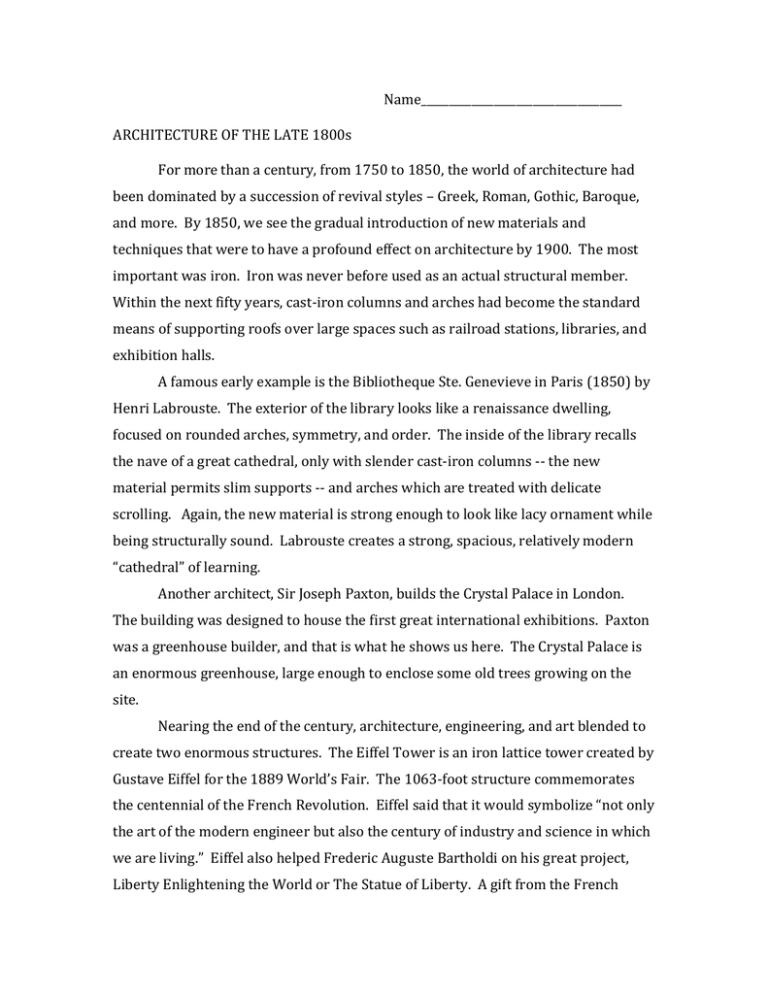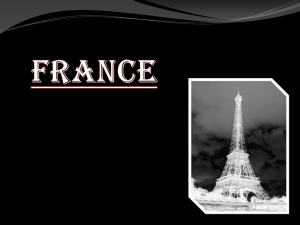Name____________________________________ ARCHITECTURE OF THE LATE 1800s
advertisement

Name____________________________________ ARCHITECTURE OF THE LATE 1800s For more than a century, from 1750 to 1850, the world of architecture had been dominated by a succession of revival styles – Greek, Roman, Gothic, Baroque, and more. By 1850, we see the gradual introduction of new materials and techniques that were to have a profound effect on architecture by 1900. The most important was iron. Iron was never before used as an actual structural member. Within the next fifty years, cast-iron columns and arches had become the standard means of supporting roofs over large spaces such as railroad stations, libraries, and exhibition halls. A famous early example is the Bibliotheque Ste. Genevieve in Paris (1850) by Henri Labrouste. The exterior of the library looks like a renaissance dwelling, focused on rounded arches, symmetry, and order. The inside of the library recalls the nave of a great cathedral, only with slender cast-iron columns -- the new material permits slim supports -- and arches which are treated with delicate scrolling. Again, the new material is strong enough to look like lacy ornament while being structurally sound. Labrouste creates a strong, spacious, relatively modern “cathedral” of learning. Another architect, Sir Joseph Paxton, builds the Crystal Palace in London. The building was designed to house the first great international exhibitions. Paxton was a greenhouse builder, and that is what he shows us here. The Crystal Palace is an enormous greenhouse, large enough to enclose some old trees growing on the site. Nearing the end of the century, architecture, engineering, and art blended to create two enormous structures. The Eiffel Tower is an iron lattice tower created by Gustave Eiffel for the 1889 World’s Fair. The 1063-foot structure commemorates the centennial of the French Revolution. Eiffel said that it would symbolize “not only the art of the modern engineer but also the century of industry and science in which we are living.” Eiffel also helped Frederic Auguste Bartholdi on his great project, Liberty Enlightening the World or The Statue of Liberty. A gift from the French people for our centennial, the statue was designed by Bartholdi with Eiffel’s assistance. Eiffel engineered how the copper skin would be supported – not by masonry as Bartholdi originally planned, but by an iron support structure. These two colossal structures truly bend the boundaries between sculpture and architecture. Blending the arts further, The Statue of Liberty’s famous inscription comes from a popular poem of the era. It is attached to the last page. Bibliotheque Ste Genevieve Bibliotheque Ste Genevieve, interior The Crystal Palace Eiffel Tower, photo of the first stages of construction Liberty Enlightening the World, head on display (see man in corner!)






